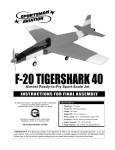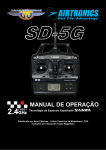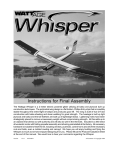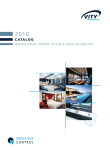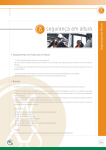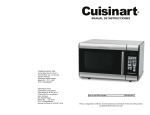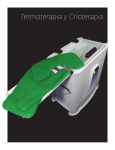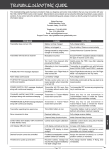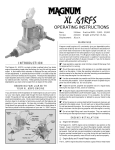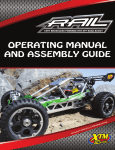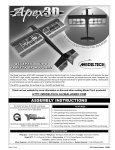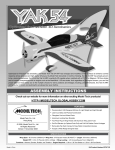Download Model Tech Mini Mach Racer Specifications
Transcript
ASSEMBLY INSTRUCTIONS Check out our website for more information on other exciting Model Tech products! http://modeltech.globalhobby.com features l l Model Tech Co., Ltd. Hong Kong © 2008, Model Tech Co., Ltd. All Rights Reserved Version 1 May 2008 Great Flight Characteristics - High Speed Yet Stable Flight Envelope All Wood Construction l Lightweight, Laser-Cut Parts l Covered with Iron-On Covering in a Bright, Easy-to-See Colour Scheme l Easy-Acess Battery Compartment l High-Quality Hardware l Detailed Assembly Instructions with Digital Photos specifications Wing Span: 23 Inches (584mm) l Wing Area: 250 Square Inches (16.13dm2) Weight RTF: 16 Ounces (454gr) l Functions: Elevons (Electronic Elevon Mixing) and Throttle l Electronic Speed Control Required: 18 Amp Brushless Made in China l Length: 18 Inches (457mm) Wing Loading: 9.5 Ounces/Square Foot (28.12gr/dm2) Page Motor Required: 2208/09 Brushless Outrunner l Battery Required: 3 Cell 950mAH LiPO Kit Product Number MT3211C TABLE OF CONTENTS INTRODUCTION...........................................................................2 ELEVON CONTROL SYSTEM INSTALLATION............................7 SAFETY WARNING......................................................................2 LANDING SKID AND MOTOR INSTALLATION............................9 OUR GUARANTEE.......................................................................2 VERTICAL STABILISERS INSTALLATION.................................12 OUR RECOMMENDATIONS........................................................3 FINAL ASSEMBLY.......................................................................13 A NOTE ABOUT COVERING MATERIAL.....................................3 C/G AND BALANCING................................................................15 LITHIUM POLYMER BATTERY WARNINGS - PLEASE READ.... 4 AIRCRAFT SETUP INFORMATION............................................15 TOOLS AND SUPPLIES REQUIRED...........................................5 CONTROL THROWS..................................................................16 KIT CONTENTS............................................................................5 PREFLIGHT CHECK AND SAFETY...........................................17 TIPS FROM THE PROS................................................................6 REPLACEMENT PARTS LIST....................................................17 CONTROL SURFACE HINGING...................................................6 PRODUCT EVALUATION SHEET...............................................19 INTRODUCTION Thank you for purchasing the Model Tech Mini Mach Racer EP ARF. We're confident that the quality of your new aircraft meets and even exceeds your expectations. Before completing the final assembly of your new aircraft, please carefully read through these assembly instructions in their entirety. Doing so will ensure your success the first time around! These assembly instructions are designed to guide you through the entire assembly process of your new aircraft in the least amount of time possible. Along the way you'll learn how to properly assemble your new aircraft and also learn tips that will help you in the future. We have listed some of our recommendations below. Please read through them before beginning assembly. Please read through each step before beginning assembly. You l Keep a couple of small bowls or jars handy to put the small parts should find the layout very complete and straightforward. Our goal in after you open the accessory bags. is to guide you through assembly without any of the headaches and l We're all excited to get a new aircraft in the air, but take your hassles that you might expect. time. This will ensure you build a straight, strong and great flying l There are check boxes next to each procedure. After you aircraft. complete a procedure, check off the box. This will help prevent you l If you come across this symbol , it means that this is an from losing your place. important point or an assembly hint. l + Cover your work table with brown paper or a soft cloth, both to protect the table and to protect the parts. l SAFETY WARNING This R/C aircraft is not a toy! If misused or abused, it can cause serious bodily injury and/or damage to property. Fly only in open areas and preferably at a dedicated R/C flying site. We suggest having a qualified instructor carefully inspect your aircraft before its first flight. Please carefully read and follow all instructions included with this aircraft, your radio control system and any other components purchased separately. OUR GUARANTEE Model Tech guarantees this kit to be free from defects in both material and workmanship at the date of purchase. This does not cover any component parts damaged by use, misuse or modification. In no case shall Model Tech's liability exceed the original cost of the purchased kit. In that Model Tech has no control over the final assembly or material used for final assembly, no liability shall be assumed for any damage resulting from the use by the user of the final user-assembled product. By the act of using the final user-assembled product, the user accepts all resulting liability. Page OUR RECOMMENDATIONS This section describes our recommendations to help you in deciding which types of accessories to purchase for your new aircraft. Please read through this entire section very carefully. We have provided you with recommendations that, if followed, will result in a great flying aircraft. Failure to follow our recommendations may result in a poor flying aircraft. Recommended brushless power system The Mini Mach Racer EP ARF is designed to use a brushless outrunner motor and a 3 cell LiPO battery. For good overall flight performance, we recommend using the KMS Quantum 2208/09 brushless outrunner motor, the KMS 18 amp brushless electronic speed control, an APC 6 x 4 propeller, and the Impulse Power 3 Cell 950mAH LiPO battery. It's also important that you used high-quality connectors, such as X'tra 2mm Gold Plugs. l KMS Quantum 2208/09 Brushless Outrunner l KMS 18 Amp Brushless ESC l APC 6 x 4 Composite Propeller l Impulse Power 3C 950mAH LiPO Battery l Pro-Peak Quattro DC LiPO Charger l X'tra 2mm Gold Plugs Recommended Radio, Receiver and Servos You will need to use a 4 or more channel transmitter that features elevon mixing, two 9 gram micro servos and a micro or mini receiver with matching crystal. At a minimum, the transmitter should also feature dual rates, servo reversing and end-point adjustments. Do not use short-range micro receivers. If your transmitter does not feature elevon mixing, you will need to purchase a separate electronic elevon mixer that is installed in the aircraft. IMPORTANT The elevon servos will plug separately into your receiver or elevon mixer (if your transmitter does not feature elevon mixing). The use of a Y-Harness for the elevon servos is not necessary. Here's a List of What We recommend to finish the mini mach racer EP arf QTY. 1 Airtronics RD6000 FM Radio Control System QTY. 1 Impulse Power 3 Cell 950mAH (25C) LiPO Battery QTY. 1 KMS Quantum 2208/09 Brushless Outrunner Motor QTY. 1 APC 6 x 4 Composite Propeller QTY. 1 KMS 18 Amp Brushless ESC QTY. 1 Pro-Peak Quattro DC LiPO Charger QTY. 2 Airtronics 94091Z Micro Servos QTY. 1 X'tra 2mm Gold Connector Set QTY. 1 Cirrus RX-8 FM Dual Conversion Receiver QTY. 1 Double-Sided Foam Tape QTY. 1 Cirrus Crystal for FM Dual Conversion Receivers QTY. 1 Great Planes 1/4" (3mm) Black Striping Tape (Optional) A NOTE ABOUT COVERING MATERIAL The covering material used on your aircraft is real iron-on, heat-shrink covering material. It is possible with heat and humidity changes that the covering material on your aircraft may wrinkle or sag. This trait is inherent in all types of heat-shrink material. To remove any wrinkles that might be visible you will need to use a heat-sealing covering iron. Follow this simple procedure to remove the wrinkles: q Plug in and turn on the sealing iron to the medium-high temperature setting. Allow the sealing iron to heat up for approximately 5 - 7 minutes. q After the sealing iron has reached temperature, lightly apply the sealing iron to the wrinkled section of the covering material. Move the sealing iron slowly over the wrinkled section until the covering material tightens and the wrinkles disappear. +If the color layer smears from any of the seams the temperature of the sealing iron is too hot. Turn the temperature dial down and wait about 5 minutes for the sealing iron to adjust to the lower temperature. You can remove any excess color streaks using a paper towel soaked with a small quantity of acetone. Page LITHIUM POLYMER BATTERY WARNINGS - PLEASE READ WARNINGS AND SAFETY PRECAUTIONs FOR ALL BRANDS OF LITHIUM POLYMER BATTERIES Please read and understand the warnings listed in this section. Make sure to read any and all warnings included in the packaging with your battery, too. If used improperly, lithium polymer batteries can be very dangerous, so please follow these warnings and suggestions at all times. This product may explode or catch fire. Serious injury can result from misuse. Serious injury, loss of property, fire and death can result from misuse of this product. l All instructions, warnings and cautions must be followed at all times. Failure to do so can lead to serious injury or fire. l Do NOT use this product before reading and understanding all directions and warnings. l Do NOT overcharge. Maximum voltage for each pack must be followed. l Do NOT over-discharge. NEVER discharge below minimum volts. l Do NOT discharge at a rate greater than the maximum continuous discharge. l Do NOT use or charge if the battery is hot. l ONLY use a charger made for Lithium Polymer batteries. l Do NOT charge at a rate higher than 1C. Example: if the battery’s rating is 340mAH, then the charger’s charge rate must be set at 340mAH or less. l Do NOT leave in direct sunlight or in a hot car or storage area. l Do NOT get wet or expose to moisture. l Do NOT short-circuit the battery. l ONLY discharge and charge the battery outdoors or in a firesafe container. l Do NOT charge with reverse polarity. l Do NOT leave the battery connected when not in use. l Do NOT operate or charge unattended. l Do NOT solder to the battery directly and do not get the battery hot in any way. l charging warnings and precautions for all brands of lithium polymer batteries l Do NOT use the product if you do not understand the warnings and proper use of the product. Always let the battery cool and "rest" between uses and charging. l To avoid over-discharging, only use a speed control that is made for LiPO batteries. l We recommend the use of a firesafe container when charging or storing. l Do NOT charge inside your car or inside your house. l Inspect the battery before each use for swelling or other malformation. If the cell has ballooned, it MUST be discarded. l Set the charger to 1C (charge at 1/2C or less for the first 5 cycles). l Check polarity and then connect battery to charger. l In use, do not over-discharge or exceed maximum discharge. l When handling the battery, remember not to poke, bend or damage the cells. The cell's outer casing is soft and can be damaged. l Remember, the cells must never exceed 160º Fahrenheit (71º Celcius) for any reason. l Page TOOLS AND SUPPLIES REQUIRED q 5 Minute Epoxy q 220 Grit Sandpaper q Thin and Thick C/A q Sanding Block q C/A Debonder q Masking Tape q Formula 560 Canopy Glue q Paper Towels q # 1 and # 2 Phillips Head Screwdrivers q Rubbing Alcohol q Wire Cutters q Epoxy Mixing Sticks q Needle Nose Pliers q Epoxy Mixing Cups q Modeling Knife q Soldering Iron q Scissors q Solder q Electric or Hand Drill q Heat-Shrink Tubing (Assorted Sizes) q Assorted Drill Bits q Heat Gun (for Heat-Shrink Tubing) q Straight Edge Ruler q Heat Sealing Iron (for Covering Material) q Pencil q White Covering Material 1/2" x 24" (1.3cm x 61cm) q Builder's Triangle KIT CONTENTS Before you begin assembly, group the parts as we list them below. This will ensure that you have all of the parts before you begin assembly and it will also help you become familiar with each part. If you find any parts missing or damaged, please contact your local model tech dealer directly, using the separate Customer service sheet included with your kit. AIRFRAME ASSEMBLIES q (1) Wing with Hatch Cover q (1) Right Elevon q (1) Left Elevon q (2) Vertical Stabilisers CONTROL SYSTEM ASSEMBLIES q (2) 5-3/4" (146mm) Threaded Wires with Z-Bends q (2) Nylon Control Horns with Backplates q (2) Nylon Clevises q (6) M2 x 16mm Machine Screws q (6) C/A-Style Hinges MISCELLANEOUS PARTS q (1) Cowling q (1) Canopy q (1) Landing Skid q (2) Plywood Spacer Plates q (1) Hook and Loop Material q (4) M3 x 12mm Machine Screws q (4) M3 x 18mm Machine Screws q (4) M3 Flat Washers q (4) M2 x 10mm Washer-Head Wood Screws q (1) Decal Sheet (Not Pictured) Page TIPS FROM THE PROS During the covering process, sometimes color may smear slightly from the seams. If you see any smeared colors on the covering material, they can be quickly removed by simply wiping them off with a paper towel and a small amount of acetone. l l Make sure to test-fit the parts together before applying glue. This will ensure that the parts fit properly before gluing them together. When gluing anything that has a smooth surface, it's important to lightly roughen the gluing surfaces with 220 grit sandpaper. This will allow the glue to stick better. Also, never glue directly to the covering material. Always remove the covering material from the gluing surfaces prior to gluing the parts together. l When cutting away the covering material from the gluing surfaces, be careful to cut only through the covering material. Try not to cut down into the balsa structure because that can compromise the integrity of the airframe. l We do not suggest storing your aircraft in an extremely hot environment (like the back of your car in direct sunlight) for any length of time. The extreme heat could cause the covering material to wrinkle or sag and possibly damage the fragile components of the radio control system and/or LiPO battery. l l Epoxy can be cleaned up before it dries using rubbing alcohol, and C/A can be cleaned up before it dries using C/A Debonder. To prevent current loss, make sure to use high-quality connectors between the battery and the ESC, and between the ESC and the motor. l l Insulate solder joints with heat-shrink tubing to prevent short circuits and corrosion. CONTROL SURFACE HINGING You'll Need the following parts FROM THE KIT: q (1) Wing with Hatch Cover q (1) Left Elevon q (1) Right Elevon q (6) C/A-Style Hinges You'll Need the following TOOLS AND SUPPLIES: q Thin C/A q T-Pins q C/A Debonder q Paper Towels q Modeling Knife Step 1: hinging the elevons IMPORTANT The hinges are NOT glued into place from the factory, they are simply slid into place dry for shipping purposes. You must glue them into place. C/A-style hinges are used to hinge the control surfaces. These hinges are designed to be glued into place using thin C/A. Do not glue these hinges into place using any other type of glue, such as thick C/A or epoxy. Use of any adhesive other than thin C/A could result in failure of the hinges during flight. For flutter-free control surfaces and crisp control response, it is imperative that the hinges be glued in properly. This is achieved by having a tight hinge gap [no more than 1/32" (.7mm) wide] and using plenty of thin C/A glue. Poor hinge installation can lead to control surface flutter which can result in a catastrophic failure of the airframe. q Remove the two elevons and the six C/A-style hinges from the wing. q Working with one elevon for now, push two T-Pins through the centre of each of the three hinges. PRO TIP The T-Pins will keep the hinges centred and square to the hinge line while you are hinging the elevon. Page q Slide one hinge into each of the three hinge slots in the elevon, making sure that you push each hinge in up to the T-Pins. IMPORTANT Don't glue the hinges into the elevon yet. q Push the elevon and hinges into the corresponding three hinge slots in the trailing edge of the wing. q Remove the T-Pins and push the elevon up against the trailing edge. There should be no more than a 1/32" (.7mm) wide hinge gap and the outer end of the elevon should not touch the wing when the elevon is deflected. q While holding the elevon tight against the trailing edge, pivot the elevon down 45º and apply 5-6 drops of thin C/A to the exposed area of each hinge, then turn the wing over and repeat for the other side of the hinges. q Allow the C/A to dry for about 15 minutes, then pivot the elevon up and down several times to free up the hinges. IMPORTANT Check the integrity of the hinges after the C/A fully cures by gently pulling on the elevon. If one or more hinges feels loose, apply more C/A to the hinge(s) and allow it to completely cure. The last thing you want is for a hinge to come loose during flight. q Repeat the previous procedures to hinge the second elevon to the other side of the wing. ELEVON CONTROL SYSTEM INSTALLATION You'll Need the following parts FROM THE KIT: q (2) 5-3/4" (146mm) Threaded Wires with Z-Bends q (2) Nylon Clevises q (2) Nylon Control Horns with Backplates q (6) M2 x 16mm Machine Screws You'll Need the following TOOLS AND SUPPLIES: q Thin C/A q 1/16" (1.6mm) and 5/64" (2mm) Drill Bits q # 1 Philips Head Screwdriver q Straight Edge Ruler q Needle Nose Pliers q Pencil q Modeling Knife q Masking Tape q Electric or Hand Drill Page Step 1: installing the elevon servos q Cut away the covering material from over the two elevon servo mounting holes in the bottom of the wing. One servo mounting hole is located on each side of the wing, 1/2" (13mm) out from the sides of the radio compartment and 6" (152mm) in front of the elevon hinge lines. q Working with one elevon servo for now, run the servo lead through the precut slot in the inboard side of the servo mounting hole and into the radio compartment. IMPORTANT Depending on the dimensions of your elevon servo, you may need to cut the servo mounting hole slighly larger to fit before installing the servo in the next procedure. q Install your elevon servo into the servo mounting hole, using the mounting screws provided with your servo, then repeat the previous procedures to install the second elevon servo into the other half of the wing. IMPORTANT The servo output shaft should be toward the front of the wing. +Make sure to drill pilot holes through the wing for the servo mounting screws. Step 2: installing the elevon control linkages q Position and mark the mounting hole locations for the control horn on the bottom of one elevon. When aligned properly, the centreline of the control horn should be positioned 1-1/4" (32mm) out from the inboard edge of the elevon (measured at the hinge line) and the clevis attachment holes should be lined up over the hinge line. The base of the control horn should be parallel to the hinge line, too. q Drill 5/64" (2mm) diameter pilot holes through the elevon for the control horn mounting screws, then apply a couple of drops of thin C/A into the pilot holes. Allow the C/A to fully cure. +The C/A will harden the surrounding wood, making the mounting area stronger. q Install the control horn and backplate, using three M2 x 16mm machine screws, then use wire cutters to cut the top of the screws flush with the control horn backplate. Page q Enlarge the hole in one servo arm that is 3/8" (10mm) out from the centre of the servo horn, using a 1/16" (1.6mm) diameter drill bit. q Install the Z-Bend in one pushrod wire into the hole that you enlarged in the servo arm. +The pushrod wire should be orientated on top of the servo arm. q Use a couple of pieces of masking tape, taped between the elevon and the wing, to hold the elevon centred. q Centre the elevon servo, then install the servo horn onto the servo, making sure that the servo horn is centred and pointing out toward the wing tip. q Install the servo horn retaining screw to secure the servo horn to the servo. q With both the servo horn and the elevon centred, thread one clevis onto the pushrod wire and snap the clevis into the outermost hole in the control horn. q Remove the masking tape and double-check that both the servo horn and the elevon are still centred. If necessary, thread the clevis in or out to centre the elevon, then move the elevon up and down several times to ensure proper movement. q Repeat the previous procedures to install the second elevon control linkage onto the other half of the wing. LANDING SKID AND MOTOR INSTALLATION You'll Need the following parts FROM THE KIT: q (1) Cowling q (4) M3 x 18mm Machine Screws q (1) Landing Skid q (4) M3 Flat Washers q (2) Plywood Spacer Plates q (4) M2 x 10mm Washer-Head Wood Screws q (4) M3 x 12mm Machine Screws You'll Need the following TOOLS AND SUPPLIES: q Thin and Thick C/A q 1/16" (1.6mm) Drill Bit q # 2 Philips Head Screwdriver q Straight Edge Ruler q Modeling Knife q Pencil q Scissors q 220 Grit Sandpaper with Sanding Block q Electric or Hand Drill q Masking Tape Page Step 1: installing the landing skid q Cut away the covering material from over the landing skid mounting slots in the bottom of the wing, then test-fit and glue the landing skid firmly into place, using a generous amount of thick C/A. IMPORTANT Make sure to cut away the covering material from over the gluing surfaces to ensure a strong bond. Step 2A: installing the motor - with bolt-on threaded propeller adapter IMPORTANT Two different types of motor are showed installed. The first type shown in step 2A is an outrunner motor that uses a backplate mount and a bolt-on threaded propeller adapter. This type of motor requires using the two plywood spacer plates and four 18mm long machine screws to install. The second type shown in step 2B is an outrunner motor that uses a backplate mount and a slide-on propeller adapter. This type of motor does not require any spacer plates and uses four12mm long machine screws to install. Please follow the step that matches the motor type that you're using. q Install the propeller adapter and the backplate mount (both included with your motor) onto your brushless outrunner motor, following the procedures in your motor's user's guide. IMPORTANT The preinstalled blind nuts in the firewall are spaced to fit a majority of 4-hole radial backplate mounts of motors within the specifications of the aircraft. If your motor's backplate mount uses a different mounting hole pattern, you will need to drill new mounting holes and reinstall the blind nuts to match. IMPORTANT The two plywood spacer plates are provided to push your motor out far enough so that the front of the propeller adapter is approximately 1/16" (1.6mm) in front of the fuselage sides. q Install your motor, using two plywood spacer plates, four M3 x 18mm machine screws and four M3 flat washers, making sure to tighten the machine screws firmly. Step 2B: installing the motor - with slide-on propeller adapter q Install the backplate mount (included with your motor) onto your brushless outrunner motor, following the procedures in your motor's user's guide. IMPORTANT The preinstalled blind nuts in the firewall are spaced to fit a majority of 4-hole radial backplate mounts of motors within the specifications of the aircraft. If your motor's backplate mount uses a different mounting hole pattern, you will need to drill new mounting holes and reinstall the blind nuts to match. Page 10 q Install your motor, using four M3 x 12mm machine screws and four M3 flat washers, making sure to tighten the machine screws firmly. IMPORTANT It's not necessary to use the two plywood spacer plates with this type of motor. Step 3: installing the cowling q Cut out the back of the cowling along its base, making sure to cut the back edge straight. q Using the moulded scribe lines as a guide, cut out the sides of the cowling to clear the wing leading edges, then cut out the holes in the front and the bottom of the cowling for the propeller adapter and the three cooling intake holes. IMPORTANT Depending on the motor that you're using, you may need to cut out more of the front of the cowling than shown. q Slide the cowling onto the front of the aircraft and align it. When aligned properly, the hole in the middle of the cowling should be centred around the motor shaft and the back of the cowling should fit flush against the surface of the aircraft. The cutouts in the side of the cowling should fit over the contour of the wing leading edges, too. IMPORTANT You may need to cut a notch in the bottom of the cowling to fit around the front of the landing skid. q When satisfied with the fit and alignment, hold the cowling securely in place, using a couple of pieces of masking tape. q Drill two 1/16" (1.6mm) diameter pilot holes through each side of the cowling for the wood screws. Position one pilot hole centred between the top of the cowling and the top of the wing, and one pilot hole centred between the bottom of the cowling and the bottom of the wing. All four pilot holes should be 1/8" (3mm) in front of the back edge of the cowling. q Remove the cowling and apply a couple of drops of thin C/A into the four pilot holes and allow the C/A to fully cure. q Install the cowling, using four M2 x 10mm washer-head wood screws. Page 11 VERTICAL STABILISERS INSTALLATION You'll Need the following parts FROM THE KIT: q (2) Vertical Stabilisers You'll Need the following TOOLS AND SUPPLIES: q 5 Minute Epoxy q Paper Towels q Modeling Knife q Rubbing Alcohol q Straight Edge Ruler q Epoxy Mixing Sticks q Pencil q Epoxy Mixing Cups q Builder's Triangle Step 1: Aligning the Vertical stabilisers q Cut away the covering material from over the two vertical stabiliser mounting slots in the top of the wing. Each mounting slot is 3/16" (5mm) wide and 3-3/8" (86mm) long. The back edge of each mounting slot is located 1-1/8" (29mm) in front of the elevon hinge line and the centre of each mounting slot is 2-1/2" (64mm) out from each side of the radio compartment. q Push one vertical stabiliser down into one mounting slot, then draw a line on each side of the vertical stabiliser where it meets the top of the wing. Draw an outline onto the top of the wing around the base of the vertical stabiliser, too. WARNING When cutting through the covering to remove it in the next step, cut with only enough pressure to cut through only the covering itself. Cutting down into the balsa structure could weaken the vertical stabiliser and cause it to fail during flight. Step 2: installing the Vertical STABILISERs q Remove the vertical stabiliser and cut away the covering material from both sides of the vertical stabiliser and from the base of the vertical stabiliser, too. q Carefully cut away the covering material from within the outline you drew on top of the wing. q Glue the vertical stabiliser into place, using 5 minute epoxy. Wipe away any excess epoxy and hold the vertical stabiliser in place until the epoxy has set up. IMPORTANT Use a builder's triangle to make sure that the vertical stabiliser is perpendicular to the wing. q Repeat the previous procedures to align and install the second vertical stabiliser on the other half of the wing. Page 12 FINAL ASSEMBLY You'll Need the following parts FROM THE KIT: q (1) Hook and Loop Material q (1) Canopy You'll Need the following TOOLS AND SUPPLIES: q Formula 560 Canopy Glue q Paper Towels q # 2 Philips Head Screwdriver q Soldering Iron q Wire Cutters q Solder q Modeling Knife q Heat Shrink q Scissors q Heat Gun q Straight Edge Ruler q Heat Sealing Iron q 220 Grit Sandpaper with Sanding Block q White Covering Material 1/2" x 24" (1.3cm x 61cm) q Masking Tape Step 1: installing the electronic speed control q Carefully solder three matching plugs onto your motor and onto your ESC. Be sure to apply heat-shrink tubing over the solder joints to insulate them from shorting out. q Mount your ESC to the front left side of the radio compartment, using a piece of double-sided foam tape (not included). PRO TIP If the the motor spins the wrong direction when powered up, swap two of the three motor wires and check again. The motor should spin counter-clockwise when viewed from the front. Do not swap the positive and negative battery wires to change the direction that the motor spins or you will damage both your ESC and your LiPO battery. Step 2: installing the receiver q Cut away the covering material from over the receiver antenna wire exit slot in the top right half of the wing. The receiver antenna wire exit slot is located 1-1/8" (29mm) in front of the elevon hinge line and 1/2" (13mm) in from the side of the vertical stabiliser. q Plug the servo and ESC leads into their proper slots in your receiver, then mount your receiver to the back of the radio compartment floor, using a piece of double-sided foam tape (not included). IMPORTANT Mount your receiver as far away from the ESC as possible to help prevent radio interference. q Uncoil the receiver antenna wire and feed it through the tube in the forward right side of the radio compartment. The tube is located 4-3/4" (121mm) behind on the firewall on the right side of the radio compartment. IMPORTANT Do not cut the receiver antenna wire shorter. Allow the excess to hang past the back of the aircraft. Page 13 Step 3: installing the flight battery q Carefully solder matching plugs onto the two battery wires on your battery and the two battery wires on your ESC. q Mount your flight battery to the front of the radio compartment floor, using the strip of hook and loop material provided. IMPORTANT The final location that the flight battery is mounted in will depend on where the aircraft balances, as described in the next section. Step 4: installing the canopy and the hatch cover q Carefully cut out the canopy along the moulded scribe line, then sand the edges of the canopy smooth. q Set the canopy onto the hatch cover and align it. When aligned properly, the sides of the canopy should be centred between the sides of the hatch cover and the front of the canopy should be approximately 3/8" (10mm) behind the front of the hatch cover. q When satisfied with the alignment, glue the canopy to the hatch cover, using a thin layer of Formula 560 Canopy Glue. PRO TIP To enhance the appearance, apply a strip of 1/4" (6mm) wide black striping tape around the base of the canopy. q Install the hatch cover onto the wing, making sure that the magnets hold the back of the hatch cover firmly in place. Step 5: installing the propeller IMPORTANT To make sure that the motor can't accidentally be turned on while you're installing your propeller, unplug the flight battery from the ESC before installing the propeller. q Install your propeller onto your motor, making sure that it's securely in place and doesn't touch the front of the cowling. q Cut away the covering material from over the air exit hole in the back of the radio compartment. Page 14 C/G AND BALANCING You'll Need the following TOOLS AND SUPPLIES: q Masking Tape q Straight Edge Ruler IMPORTANT It is critical that your aircraft be balanced correctly. Incorrectly balancing your aircraft can cause your aircraft to lose control and crash! Balance Point (C/G): l 4-1/4" (108mm) back from the leading edge of the wing, measured at the sides of the radio compartment. WARNING This is the recommended C/G location for test-flying. After you become familiar with the flying characteristics of the aircraft, you can move the C/G forward or backward to suit your flying style. We suggest moving the C/G in 1/8" (3mm) increments until you are satisfied with the result. 4-1/4" (108mm) q Apply two short pieces of masking tape onto the TOP of the aircraft, 4-1/4" (108mm) behind the leading edge, measured at the sides of the of the radio compartment. q Turn the aircraft over (upside down) and place your fingers on the masking tape, then carefully lift the aircraft. If the nose of the aircraft falls, the aircraft is nose heavy. To correct this, move the flight battery back far enough to bring the aircraft into balance. If the tail of the aircraft falls, the aircraft is tail heavy. To correct this, move the flight battery and/or receiver and ESC forward far enough to bring the aircraft into balance. IMPORTANT When balanced correctly, the aircraft should sit level or slightly nose down when you lift it up with your fingers at the C/G location. +Once you have flown and become familiar with the flight characteristics of the aircraft, the C/G can be moved fore or aft to change the flight performance. Moving the C/G back will cause the aircraft to be more responsive and aerobatic, but less stable. Moving the C/G forward will cause the aircraft to be more stable, but less responsive. See warning above. AIRCRAFT SETUP INFORMATION Before adjusting the control throws and flying your new aircraft, there are some points about the aircraft's setup that you should be aware of. We strongly suggest following these suggestions to get the most enjoyment out of your aircraft. Step 1: sealing the hinge gaps Because of the high speed that the aircraft flies at, we suggest that the elevon hinge gaps be sealed. Failure to do this can lead to control surface flutter, which can cause your aircraft to crash. Sealing the hinge gaps will also provide crisper control response and allow the aircraft to track straighter and fly truer, making trimming much easier. The hinge gaps can be sealed using heat-shrink covering material or clear vinyl tape. To seal the hinge gaps using heat-shrink covering material, follow these procedures: q Cut a piece of covering material 3/8" (10mm) wide and 8" (203mm) long. q Fold the length of covering material in half lengthwise so that there is a sharp crease down the middle of the covering material. Page 15 +Only the bottom of the hinge gap needs to be sealed. It is not necessary to seal both the bottom and the top. q Disconnect the clevis from one elevon control horn, so that the elevon can be deflected fully in both directions. q Remove the protective backing from the covering material. With the elevon fully deflected in the 'UP' position, place the length of covering material over the hinge line (on the bottom), making sure that the crease is pushed completely down into the hinge line. q With the elevon fully deflected in the 'UP' position, use a heat-sealing iron to adhere the covering material to both the trailing edge of the wing and to the leading edge bevel of the elevon. q Either trim the excess covering material flush with both surfaces or iron it down onto the wing and the elevon, as shown. q Pivot the elevon up and down several times to check for free movement, then reconnect the clevis to the control horn and repeat the previous procedures to seal the hinge gap on the second elevon. The elevons should be able to smoothly pivot completely up and completely down without interference from the covering material. Step 2: throttle management It is very important that you understand throttle management. Basically, this means no full throttle dives. Full throttle dives should be avoided so as not to cause control surface flutter and/or airframe failure. When the nose of the aircraft drops, decrease the throttle, just as in full-scale aircraft. CONTROL THROWS We recommend initially setting up the aircraft using the Test Flying control throws. These control throws are suggested for initial test flying because they will allow the aircraft to fly smoother and make it easier to control. You can increase the control throws to suit your flying style, but only AFTER you've become very familiar with the flight characteristics of the aircraft using the Test Flying control throws. Test Flying Ailerons: 3/8" (10mm)Up and Down Elevator: 3/8" (10mm) Up and Down Reflex: Both Elevons 1mm Up Reflex The aircraft requires approximately 1mm of Reflex (both control surfaces up) for neutral. To set the Reflex, centre both elevons with the wing tips, then adjust the pushrods so that both elevons are 1mm up from centre. This is the neutral point and should be the point where the control throws are measured. The control throws listed are a good starting point for test flying and general sport flying. Of course, you can adjust these control throws to suit your particular style and tastes, but realize that the aircraft will be extremely control sensitive and more difficult to control with higher control throws, particularly at high speeds. The control throws are measured at the outer tip of the control surfaces q After you're finished adjusting the control throws, you need to cut two 1/4" (6mm) lengths of silicone fuel tubing and slide one piece over each clevis. The tubing will prevent any chance of the clevises opening during flight. Page 16 PREFLIGHT CHECK AND SAFETY l Completely charge the transmitter and receiver batteries before your first day of flying. Check every bolt and every glue joint in the aircraft to ensure that everything is tight and well-bonded. This should include all of the control surface hinges as well. l l Double-check that you've installed and tightened all of the servo horn retaining screws. Double-check that the receiver, ESC and flight battery are properly secured into place. There's nothing worse than the flight battery coming loose during flight. l l Double-check the balance of the aircraft. Do this with the flight battery installed. l Check the control surfaces. They should all move in the correct direction and not bind. l Make sure that you've installed silicone fuel tubing over the clevises to prevent any chance of them opening during flight. l If your radio transmitter is equipped with dual rate switches, double-check that they are on the low-rate setting for your first few flights. l Check to ensure that all of the control surfaces are moving the proper amount in both low and high rate settings. l Check the receiver antenna wire. It should be fully extended and not coiled up inside the radio compartment. l Do not cut the receiver antenna wire shorter or the range of your radio control system will be greatly reduced. Properly balance the propeller. A propeller that is out of balance will cause excessive vibration, which could lead to motor and/or airframe failure, and it will reduce motor efficiency and power. l l Double-check that the propeller spinner nut is tightened securely. The following are our general guidelines for your safety and the safety of others. Please read and understand these safety guidelines before going out to the flying field for the first time. l Do not test-fly your aircraft for the first time without first having it safety-checked by an experienced modeler. Do not fly your aircraft higher than approximately 400 feet within 3 miles of an airport without having an observer with you. The observer should tell you about any full-size aircraft in your vicinity and you should always give the right-of-way to full-scale aircraft. l When flying at a flying field with established rules, you should abide by those rules. You should not deliberately fly your aircraft in a reckless and/or dangerous manner. l While flying, you should not deliberately fly behind the flight line. If your aircraft should inadvertently fly behind the flight line, you should change course immediately. l You should complete a successful range check of your radio equipment prior to each new day of flying, or prior to the first flight of a new or repaired aircraft. l l You should perform your initial turn after take- off away from the flightline and/or spectator area. You should not knowingly operate your R/C radio system within 3 miles of a preexisting model club flying field without a frequency sharing agreement with that club. l REPLACEMENT PARTS LIST When it comes time to order replacement parts, we recommend ordering directly from your local hobby retailer. If your hobby retailer does not stock Model Tech products, you can order replacement parts directly from your local distributor, using the separate Customer Service sheet included with your kit. Canopy.............................................................................. 115949 Decal Set........................................................................... 115953 Hatch Cover...................................................................... 115950 Assembly Instructions....................................................... 115954 Cowling.............................................................................. 115951 Hardware Set.................................................................... 115955 Vertical Stabilisers............................................................. 115952 Page 17 THIS PAGE INTENTIONALLY LEFT BLANK Page 18 PRODUCT EVALUATION SHEET Telling us what you like and don't like determines what model kits we make and how we make them. We would appreciate it if you would take a few minutes of your time to answer the following questions about this kit and your modeling interests. Simply fold this form on the dotted lines, seal with tape and mail it to us. Do not use staples and make sure our address faces out. Global Hobby Distributors will not disclose the information it collects to outside parties. Global Hobby Distributors does not sell, trade, or rent your personal information to others. Your privacy is important to us. 7) Was any of the assembly difficult for you? If yes, please explain. q Yes q No ________________________________________________ 1) Kit: Model Tech Mini Mach Racer EP ARF # MT3211C 2) Where did you learn about this kit? q Magazine Ads q Friend q Hobby Shop q Other q Internet 3) What influenced you the most to buy this kit? q Magazine Ads q Price q Type of Model q Box Art q Recommendation q Other q Internet ________________________________________________ ________________________________________________ ________________________________________________ 8) What did you like most about this kit? q Assembly Manual q Parts Fit q Hardware Supplied q Price q Other 4) Did you have any trouble understanding the written instructions? If yes, please explain. q Yes q No ________________________________________________ ________________________________________________ ________________________________________________ ________________________________________________ ________________________________________________ ________________________________________________ ________________________________________________ ________________________________________________ 6) Were any of the kit parts: q Damaged q Missing _______________________________________________ _______________________________________________ _______________________________________________ _______________________________________________ 11) How does this kit compare to similar kits by other manufacturers? q Better q As Good q Wrong Size q Wrong Shape q 21 - 30 How Many Years Have You Been in the Hobby? q Less than 1 q 2 - 4 q 5 - 7 10) Are you satisfied with the finished model? If no, please explain. q Yes q No If you checked any of the boxes above, did you contact our Customer Service Department to resolve the problem? q Yes q No What is Your Age Group: q 10 & Under q 11 - 20 What did you like least about this kit? q Assembly Manual q Parts Fit q Hardware Supplied q Price q Other 5) Did you have any trouble understanding any of the photographs? If yes, please explain. q Yes q No 9) QC # q 31 - 40 q 41 - 50 q 51 - 60 q 61 - 70 q 8 - 10 q 11 - 15 q 16 - 20 q 20 or More How Many Models Have You Purchased In the Last Year? q 0 - 1 q 2 - 4 q 5 - 7 q 8 - 10 q 71 + q 10 or More Please List any Other Modeling Interests or any Additional Information about This Product: ________________________________________________________________________________________________________________________ _________________________________________________________________________________________________________________________ ________________________________________________________________________________________________________________________ _________________________________________________________________________________________________________________________ ________________________________________________________________________________________________________________________ _________________________________________________________________________________________________________________________ ________________________________________________________________________________________________________________________ _________________________________________________________________________________________________________________________ ________________________________________________________________________________________________________________________ _________________________________________________________________________________________________________________________ ________________________________________________________________________________________________________________________ Page 19 Fold along dotted line ______________________________ ______________________________ ______________________________ Post Office will not deliver without proper postage (Return Address Here) Global Hobby Distributors Attn: Global Services 18480 Bandilier Circle Fountain Valley CA 92728-8610 Fold along dotted line Page 20




















